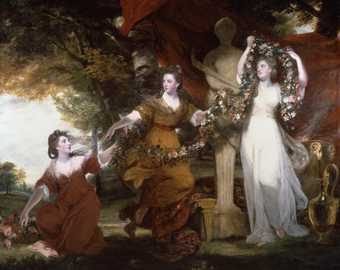
Sir Joshua Reynolds, Three Ladies Adorning a Term of Hymen 1773. Tate.
The Exhibition Age 1760–1815
17 rooms in Historic and Early Modern British Art
The first public exhibitions bring new audiences and new status to British art. This gallery recreates the spectacle of these early displays
The first temporary exhibition of contemporary art opens in London in 1760. Many more soon follow, notably the annual summer exhibitions held from 1769 by the new Royal Academy. For the thousands of visitors attending, these exhibitions can be overwhelming, unruly experiences. Noisy, hot and overcrowded, people come for the spectacle as much as for the art. They are as bursting with paintings as with people. As in this room, the pictures are densely hung from floor to ceiling in a kaleidoscope of styles and subjects.
For artists, this brings new challenges and opportunities. They worry that their work cannot be seen properly in the crowded conditions. To stand out against the competition, they bring ever greater individuality, experimentation and even flamboyance to their work. Art becomes regularly talked about in the newspapers, and reviews from critics can make or break careers.
Exhibitions become fashionable events. Artists are able to directly address more people than ever before, beyond a small number of elite patrons. To engage this wider public, their work often reflects popular interests and current affairs. Exhibitions become places where the nation’s ideas and anxieties are expressed.
There is a new buzz around British art. A sense of national identity is projected through these exhibitions. They help define a ‘British school’, which is celebrated as a sign of the nation’s cultural wealth and progress. Exhibitions contribute to how the country imagines itself on the world stage.
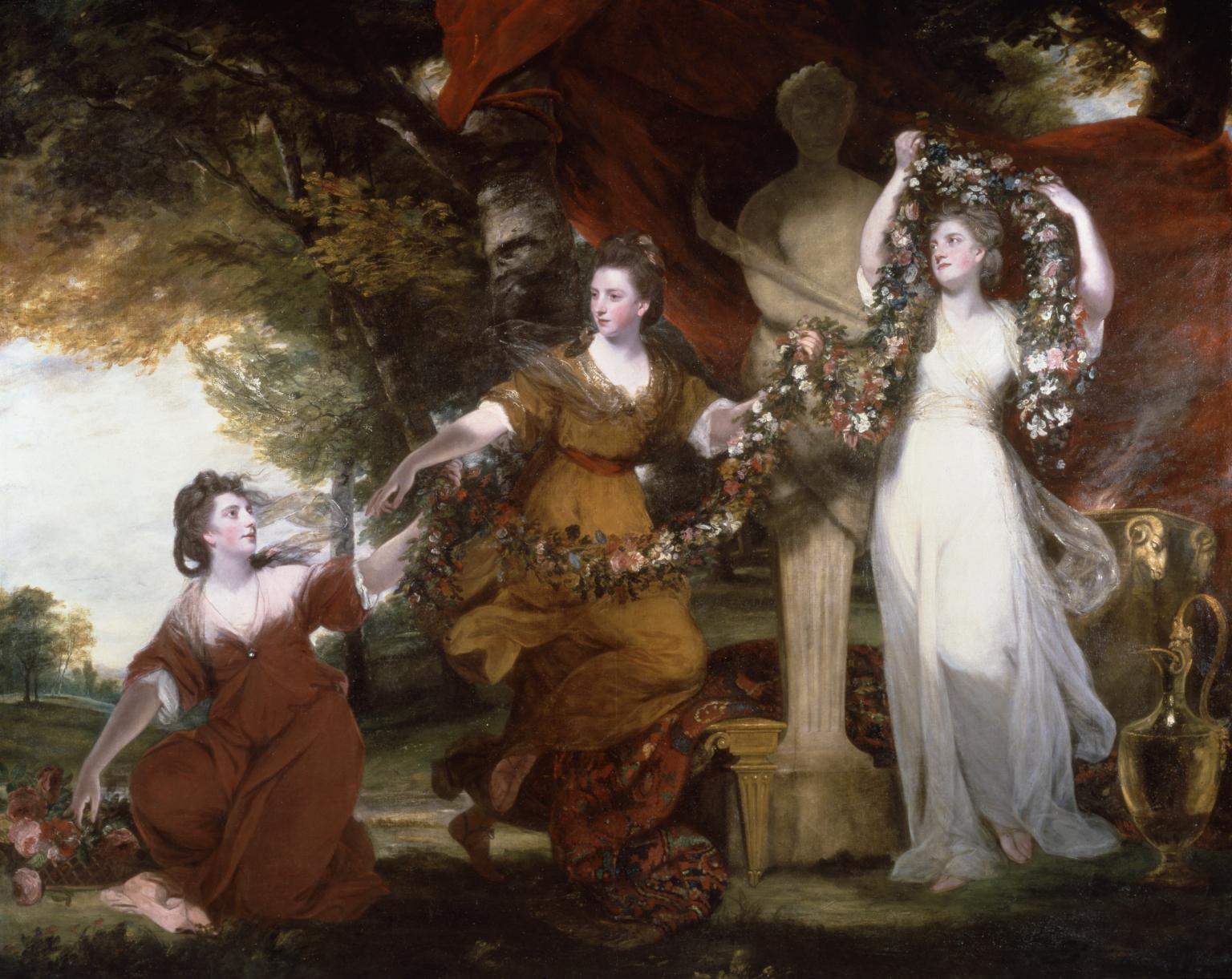
Sir Joshua Reynolds, Three Ladies Adorning a Term of Hymen 1773
The aristocratic Montgomery sisters, Barbara, Elizabeth and Anne, are shown decorating a statue of Hymen, the Greek god of marriage and fertility, with flowers. They were often nicknamed ‘The Irish Graces’, referring to the Greek goddesses of beauty and the sisters’ childhood in Ireland. The women’s poses are more often associated with the Graces than portraits of aristocratic women. The painting was commissioned by Luke Gardiner, Elizabeth Montgomery’s fiancé. A letter written by Reynolds to Gardiner promised ‘it will be the best picture I ever painted.’
Gallery label, July 2019
1/30
artworks in The Exhibition Age
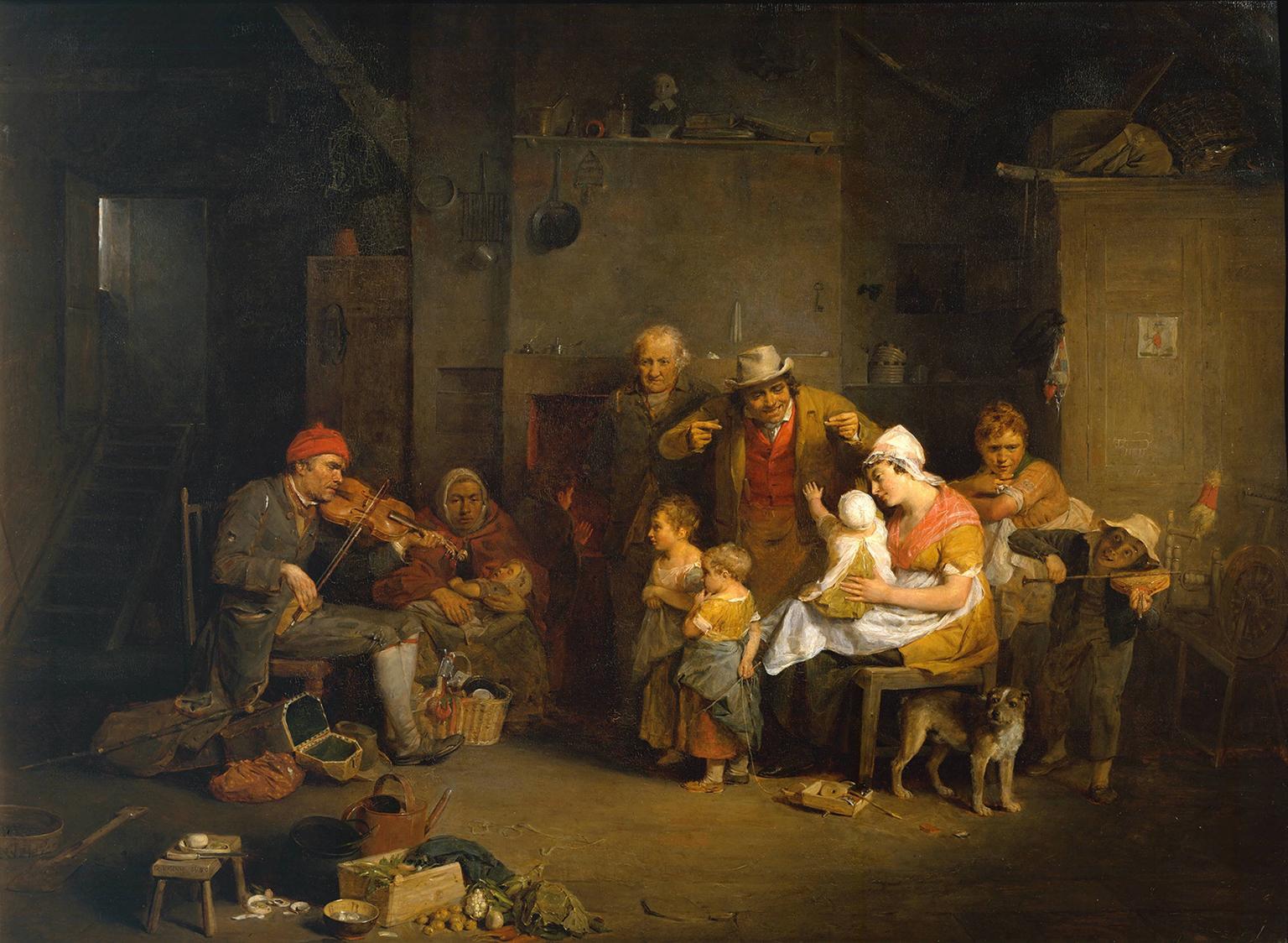
Sir David Wilkie, The Blind Fiddler 1806
In this early work by Scottish-born David Wilkie an itinerant fiddler is playing for a humble country family. Wilkie focuses on the listeners’ different expressions. Only two people seem to respond to the music: the baby and the boy on the right, who is imitating the fiddler by playing the bellows. When this picture was exhibited at the Royal Academy some critics thought the bust on the shelf represented a dissenting minister, and concluded that the family were nonconformists. The power of music to stir the passions of those supposedly suspicious of pleasure was thought to add to the painting’s subtlety.
Gallery label, February 2016
2/30
artworks in The Exhibition Age

Benjamin West, Cleombrotus Ordered into Banishment by Leonidas II, King of Sparta 1768
Benjamin West showed this painting at the second exhibition of the newly formed Royal Academy. After several years in Italy, West had established himself in London as the leading painter of subjects from classical history. His example, and the Academy’s teaching, encouraged numerous young British artists to study in Italy.
His subject is an incident from ancient Greek history. Leonidas, king of Sparta, was usurped by his son-in-law, Cleombrutus. When Leonidas returns looking for revenge, his daughter pleads for her husband’s life. Leonidas is moved by her tears, and commutes Cleombrutus’s death sentence to banishment.
Gallery label, September 2004
3/30
artworks in The Exhibition Age
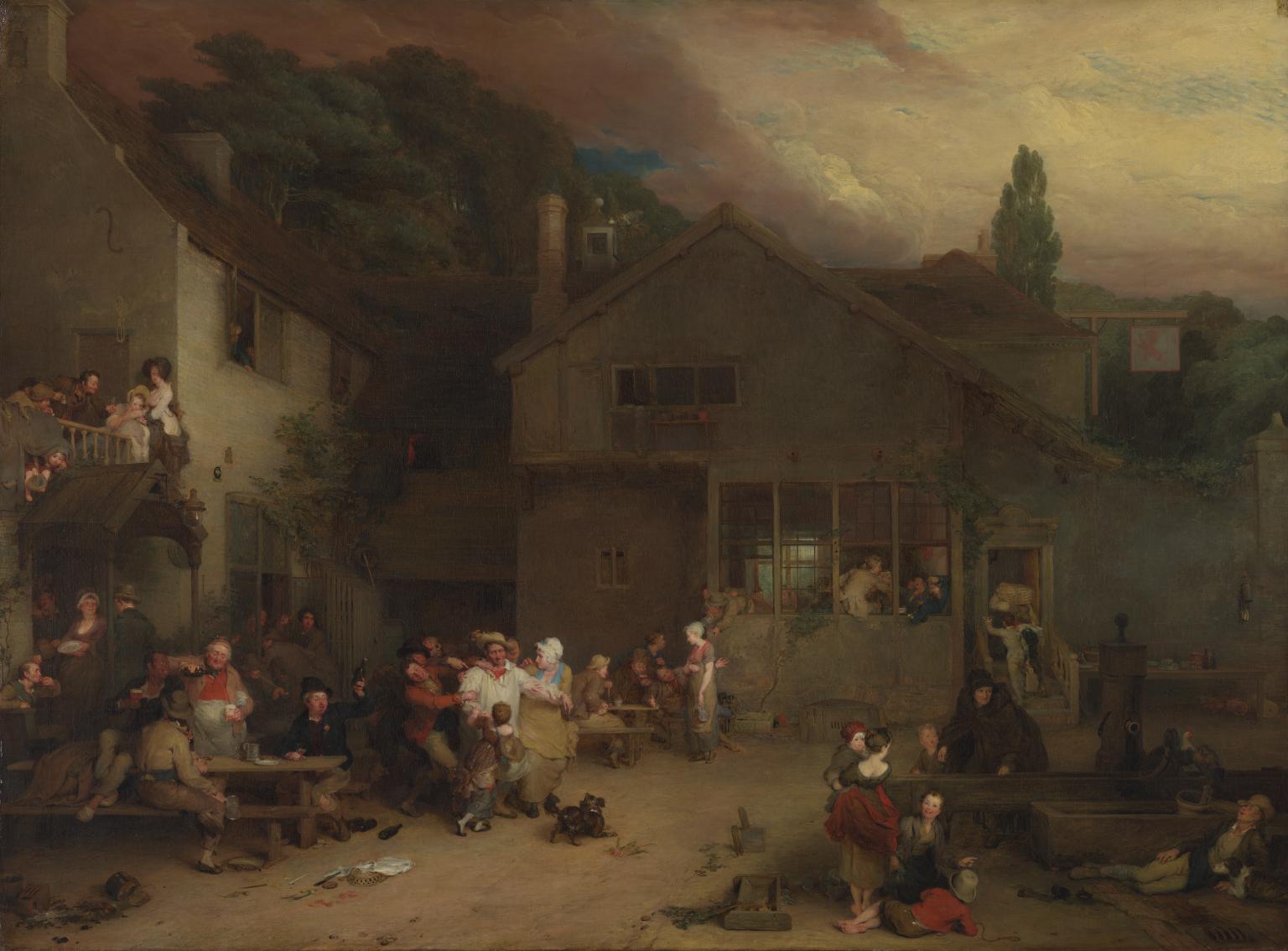
Sir David Wilkie, The Village Holiday 1809–11
Scottish-born Wilkie became a star of the London art world, widely admired for his moralising or humorous narratives of everyday life. Here, Wilkie updates the ancient theme of the choice between virtue and vice – in this case drink. Outside a pub, a man hesitates between going home to his wife or staying to drink with his friends. The consequences of a wrong decision are shown by the collapsed drunk on the right; Wilkie said even his dog looked ashamed of him. Wilkie exhibited the picture in 1812. It was bought by John Julius Angerstein, an important collector.
Gallery label, October 2013
4/30
artworks in The Exhibition Age
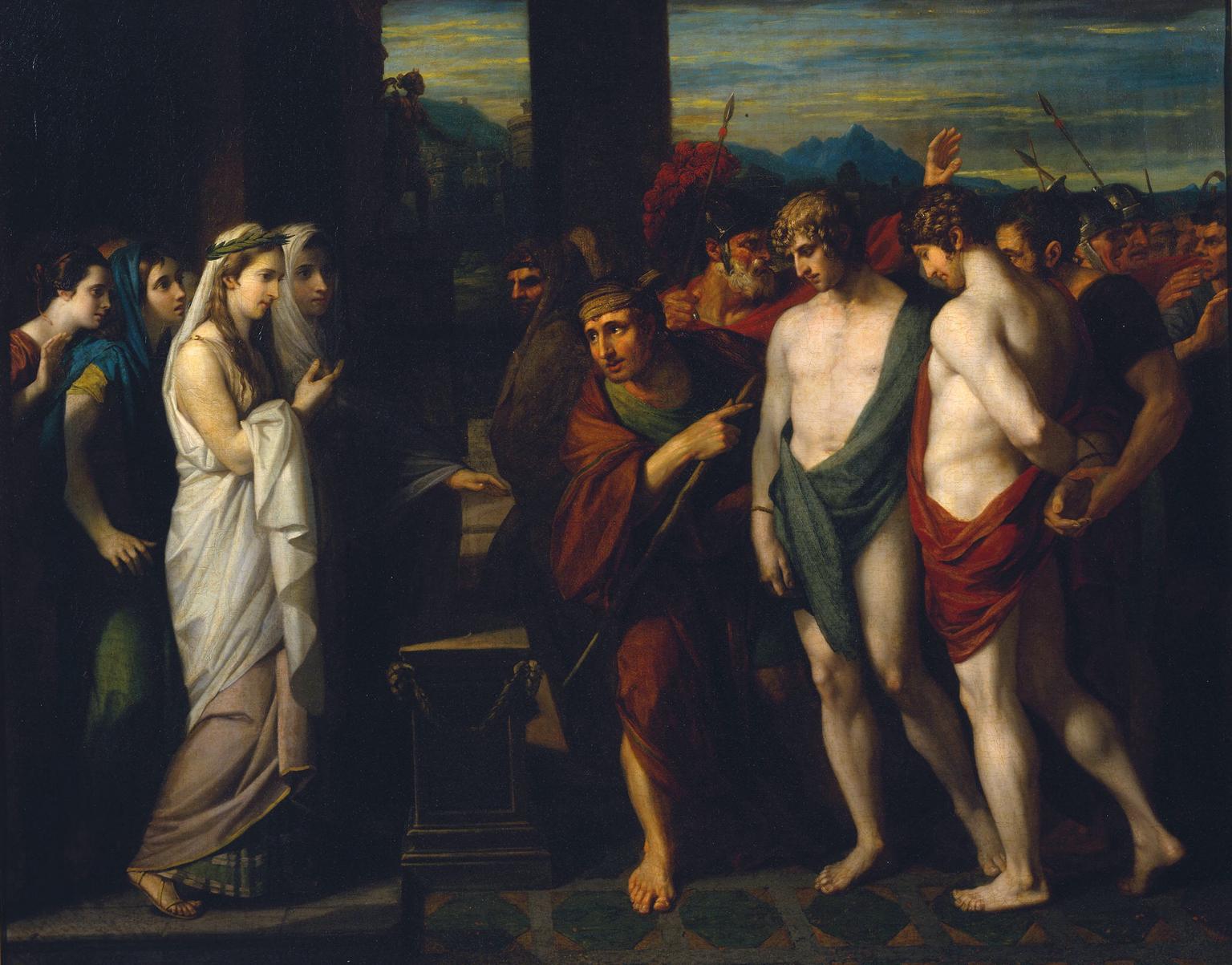
Benjamin West, Pylades and Orestes Brought as Victims before Iphigenia 1766
This painting’s story is based on a play by the classical author Euripides. The two semi-naked men have been arrested for trying to steal a gold statue of the goddess Diana from the temple. They have been brought before Iphigenia, a priestess of Diana, to be sacrificed on the altar. But here Iphigenia recognises the man in the red drapery as her long-lost brother, Orestes. The composition of this picture was heavily influenced by the artist’s studies in Italy. He particularly admired the sculptural friezes on classical tombs and the Renaissance frescoes of Raphael.
Gallery label, February 2016
5/30
artworks in The Exhibition Age

Gilbert Stuart, William Woollett the Engraver exhibited 1783
William Woollett was one of the most celebrated engravers of his day. He is shown here about to start work on his engraving of Benjamin West’s painting The Death of General Wolfe. Part of the picture can be seen in the background on the left. Although not a true representation of how an engraver would work, this portrait does show Woollett holding the copper plate on which the painting was to be reproduced. In his right hand is a pointed steel burin, or graver. It was primarily through the distribution of engravings that the image of Wolfe achieved iconic status.
Gallery label, February 2016
6/30
artworks in The Exhibition Age
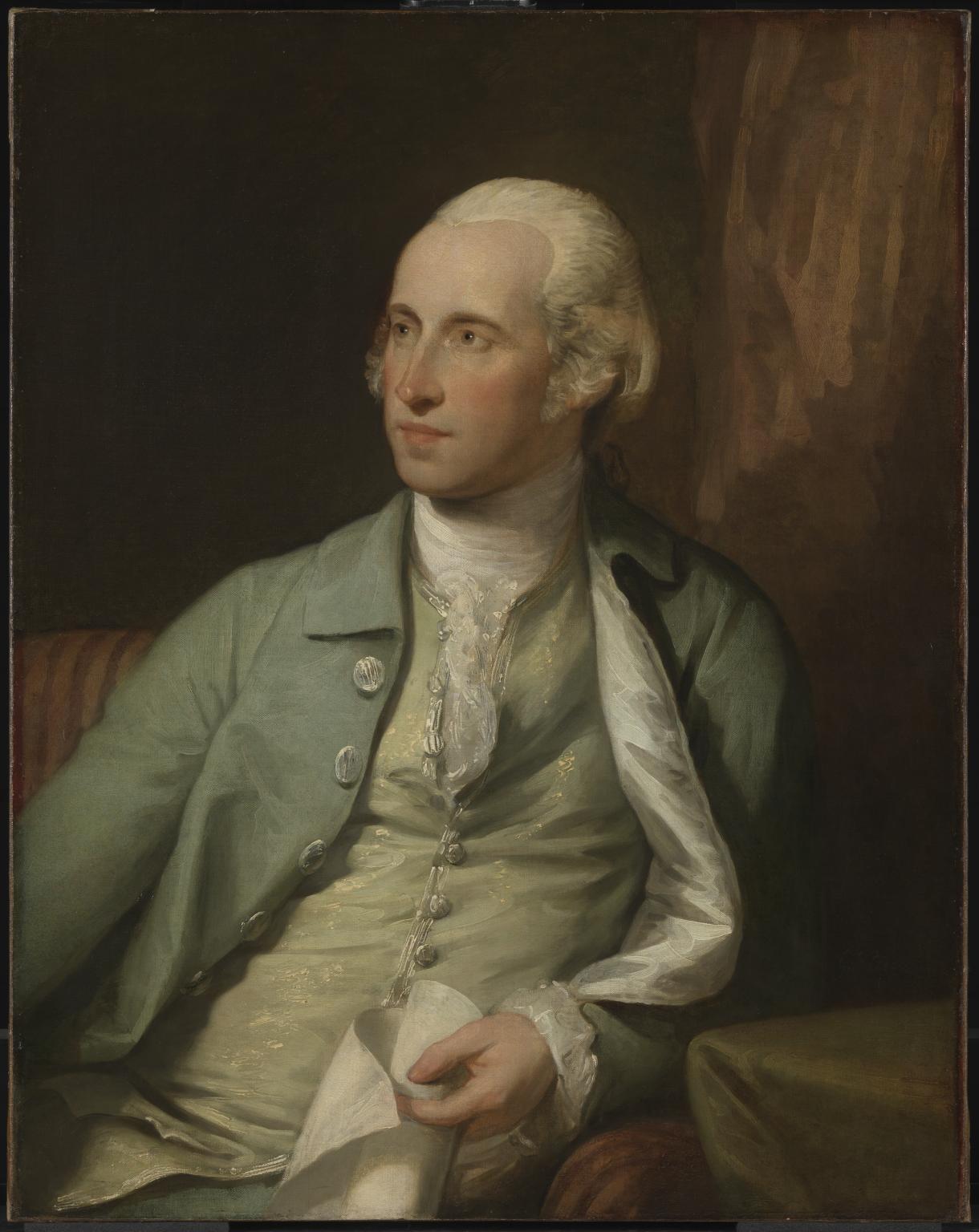
Gilbert Stuart, Benjamin West, P.R.A. ?exhibited 1781
The American-born painter Benjamin West was one of the most successful artists of his generation. He was one of King George III’s favourite artists, which gave him privileges and wealth that made him the envy of his contemporaries. This polished portrait suggests an affluent and genteel personality.
West’s studio in London was a gathering place for Americans studying art in Europe. Many of these returned home to pursue careers in their newly independent homeland. This portrait is by one of West’s most successful American students, Gilbert Stuart.
Gallery label, August 2004
7/30
artworks in The Exhibition Age

Sir Joshua Reynolds, The Age of Innocence ?1788
This picture, presented to the National Gallery in 1847, and subsequently transferred to Tate in 1951, has for many years been among Reynolds's best known works. In the nineteenth century it was deeply admired and frequently copied, National Gallery records revealing that between its acquisition and the end of the century no fewer than 323 full-scale copies in oil were made. The picture was not a commissioned portrait but a character study, or 'fancy picture', as the genre was known in the eighteenth century. The present title was not invented by Reynolds, but derives from an engraving of 1794, the second impression of which was inscribed 'The Age of Innocence'. Traditionally, it is has been thought that the picture was painted in 1788. However, it is very probably identifiable with a work exhibited by Reynolds at the Royal Academy in 1785, and entitled simply 'a little girl'. On 8 April 1785 The Morning Herald, previewing Reynolds's proposed exhibits for the forthcoming Royal Academy exhibition, noted: 'An Infant Girl, disposed on a grass plat in an easy attitude. The companion to it is a girl fondling a bird. These subjects are fancy studies of Sir Joshua's and do him honour'. A recent examination of the Age of Innocence by the conservation department at Tate has revealed that it was painted over another celebrated fancy picture by Reynolds titled A Strawberry Girl, of which several versions are known, including one in London's Wallace collection. X-radiographs of the present picture indicate that only the hands of the original Strawberry Girl remained unaltered by Reynolds. As Tate conservator Rica Jones has noted, it is possible that the Strawberry Girl was completed by Reynolds and then altered as a result of large paint losses, now made visible by x-ray (Rica Jones in Hackney et al. 1999, pp.60-5). This is not especially surprising since there are several contemporary accounts of pictures by Reynolds (including an unidentified study of a young girl) from which whole areas of paint became detached owing to the artist's defective technique. The picture was relined (backed with a new canvas) sometime in the early nineteenth century and conservation records at Tate, dating back to 1859, indicate that the painting has continued to suffer from extensive cracking and flaking.
8/30
artworks in The Exhibition Age
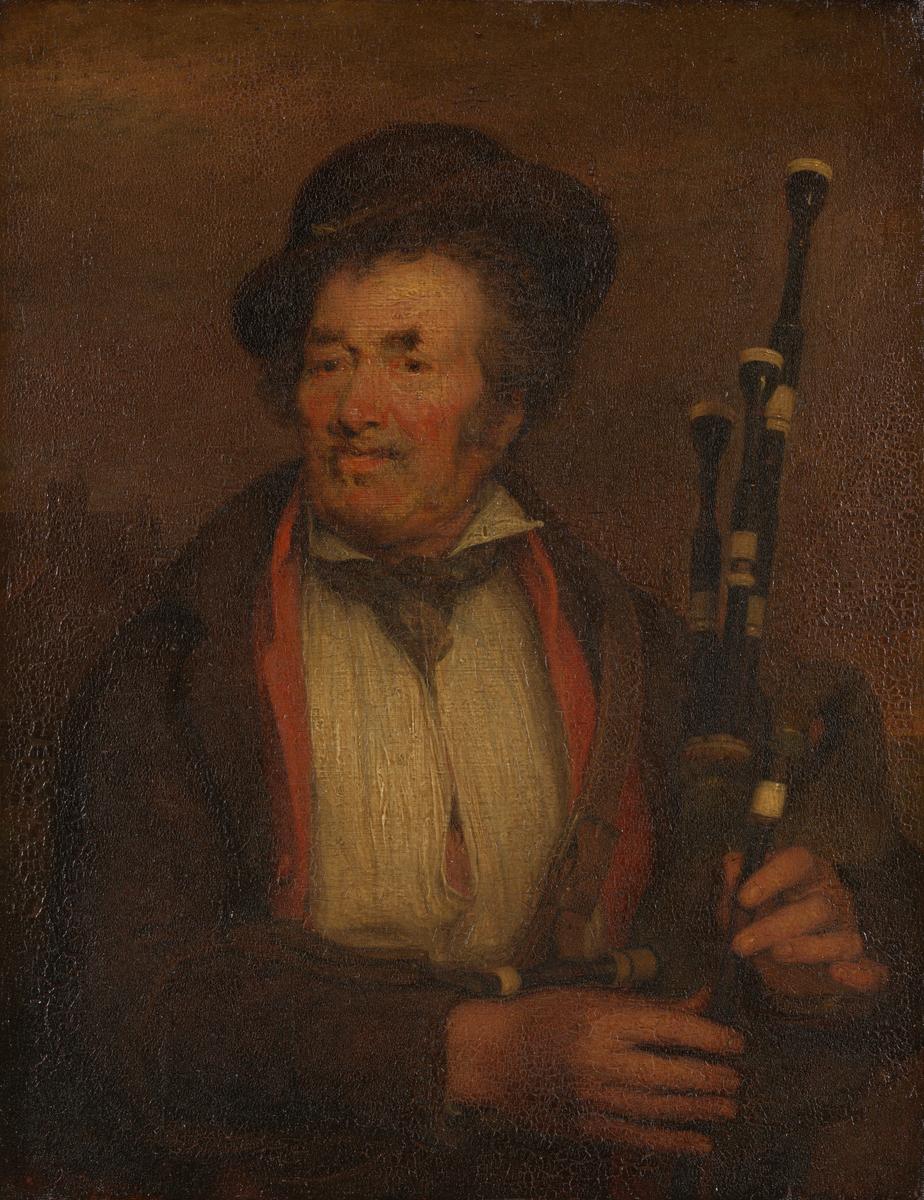
Sir David Wilkie, The Bag-Piper 1813, exhibited 1813
Wilkie exhibited this intimate portrait in 1813, when his reputation as a painter of character was already well-established. As a Scottish artist, Wilkie was keen to elevate the status of his national school. Here, however, he seems to draw on stereotypes, showing his character with a red nose and cheeks, auburn hair and thick eyebrows. These elements evoke the wildness associated with the Scots by many 19th-century English viewers. While Wilkie’s picture may appear to be taken from life, it also answered a demand for romanticised images of Scotland.
Gallery label, March 2011
9/30
artworks in The Exhibition Age
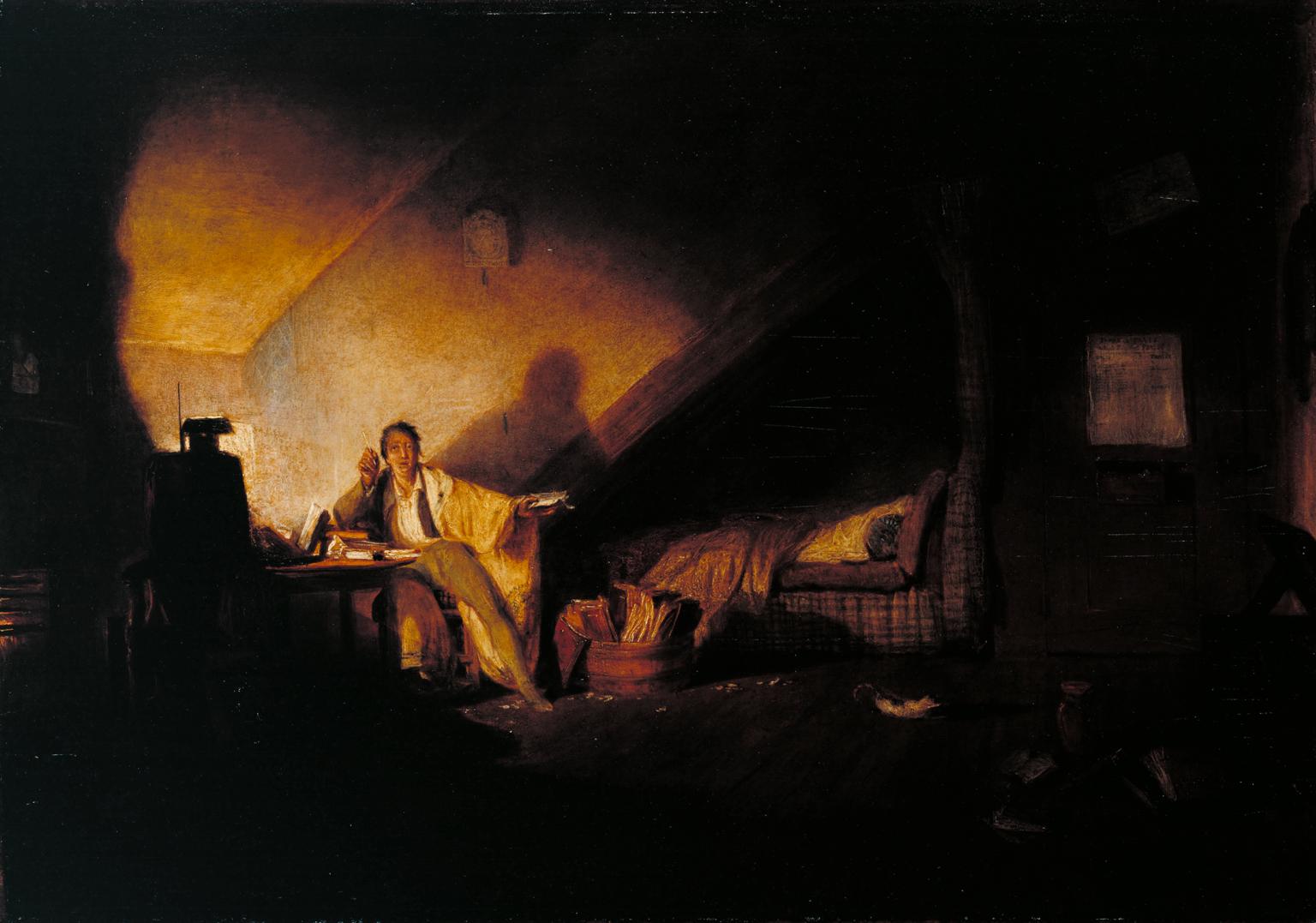
Joseph Mallord William Turner, The Garreteer’s Petition exhibited 1809
Turner rarely painted explicitly figurative works, but was inspired to do so in this case by rivalry with David Wilkie, whose genre subjects had taken the London art world by storm in 1805. The scene shows a young poet struggling for inspiration late at night in his attic room. On the wall is an image of Mount Parnassus, home of the Greek Muses, indicating his lofty ambitions. Though the point of the image seems to be satirical, the picture was exhibited at a time when Turner was producing his own verses, and he may well have sympathised with the poet’s plight.
Gallery label, August 2004
10/30
artworks in The Exhibition Age

John Opie, Portrait of a Lady in the Character of Cressida exhibited 1800
We do not know the identity of this woman, but she is probably a celebrity or actress who contemporary viewers would have recognised. Opie was working at a time when fame was becoming an increasingly important part of artistic success. This painting appeared at the Royal Academy’s annual exhibition in 1800. Artists jostled to grab public attention, painting more flamboyant and dramatic pictures. Opie depicts his sitter as the heroine of Shakespeare’s tragedy Troilus and Cressida.
Gallery label, October 2019
11/30
artworks in The Exhibition Age
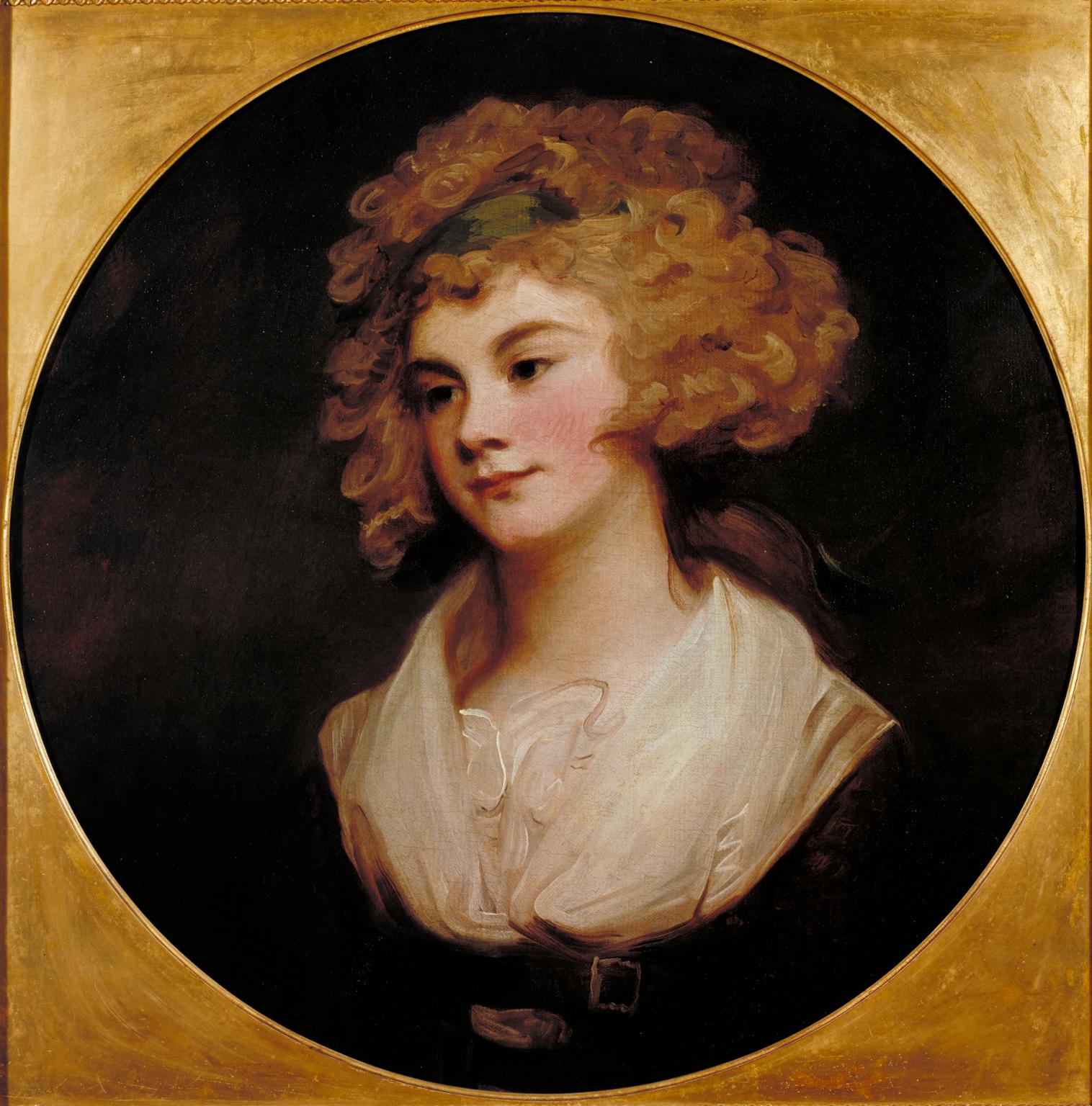
George Romney, A Lady in a Brown Dress: ‘The Parson’s Daughter’ c.1785
This portrait was originally exhibited as 'A Lady in a Brown Dress' but became known as 'The Parson's Daughter' in the later nineteenth century, when there was a fashion for giving such imaginative titles to portraits of anonymous sitters. The picture is considered to be an actual portrait rather than a 'fancy-piece', although the identity of the sitter is not known. A pencil sketch of the same subject is in the Fitzwilliam Museum, Cambridge.Romney was one of the most successful fashionable portrait painters of his time and a close rival of Reynolds and Gainsborough. His female portraits were particularly admired for their embodiment of the womanly virtues of chastity, simplicity and grace.
Gallery label, September 2004
12/30
artworks in The Exhibition Age

Thomas Stothard, Nymphs Discover the Narcissus exhibited 1793
13/30
artworks in The Exhibition Age

Henry Robert Morland, A Laundry Maid Ironing c.1765–82
This painting of a maid ironing is typical for Morland, who specialised in such ‘fancy pictures’ - subjects drawn from everyday life but with imaginative elements. He repeatedly painted and exhibited idealised pictures of young women in working-class roles, as ballad singers, oyster sellers and laundry maids. Here, the woman is shown passively gazing down, serene as she works, her tools and appearance pristine. There is little indication of her individuality, or of the real hardship of such domestic labour. Instead, she represents a contrived ‘type’, made attractive for contemporary middle and upper-class viewers and saleable for the print market.
Gallery label, June 2022
14/30
artworks in The Exhibition Age
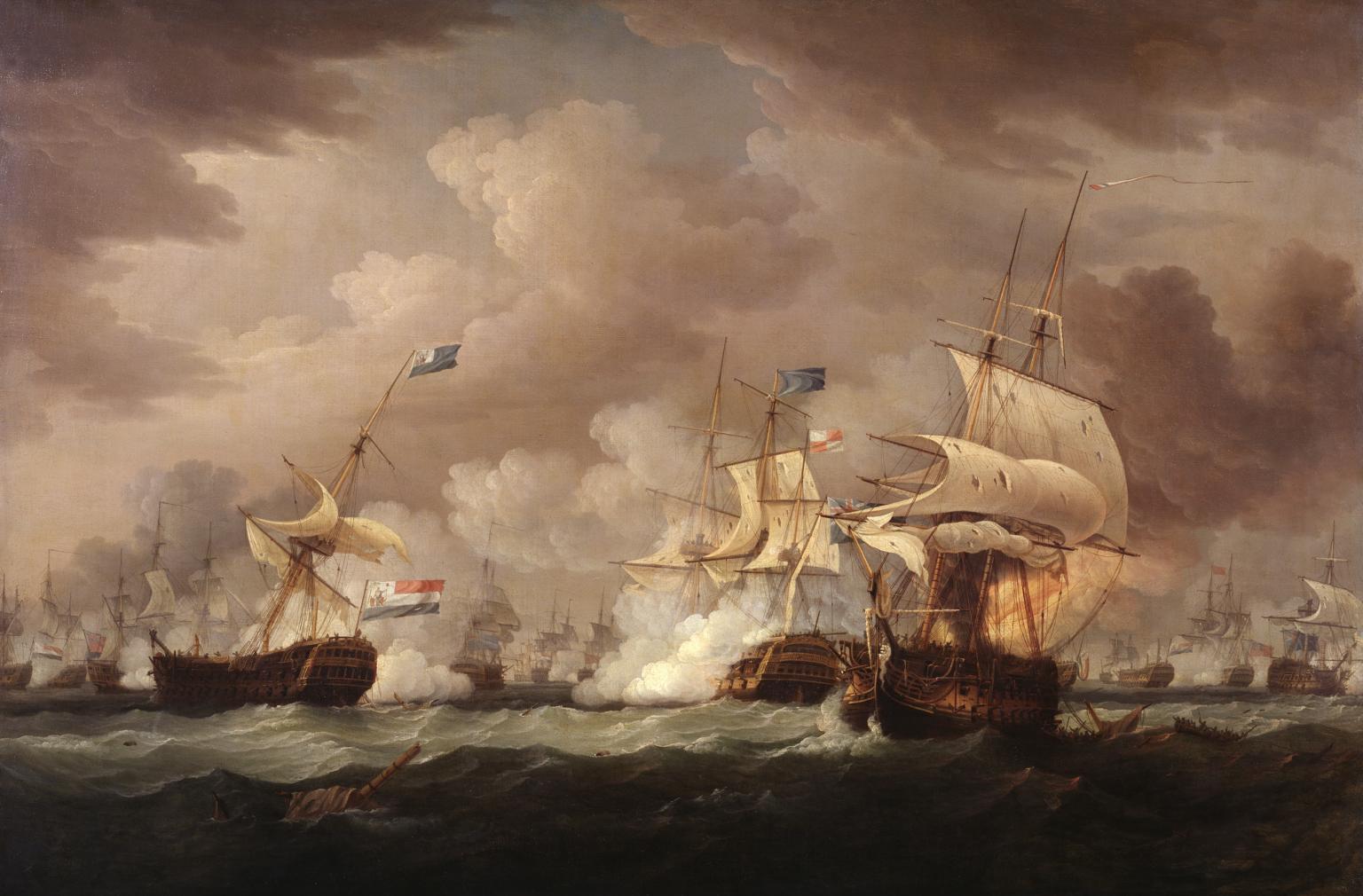
Thomas Whitcombe, The Battle of Camperdown 1798
15/30
artworks in The Exhibition Age
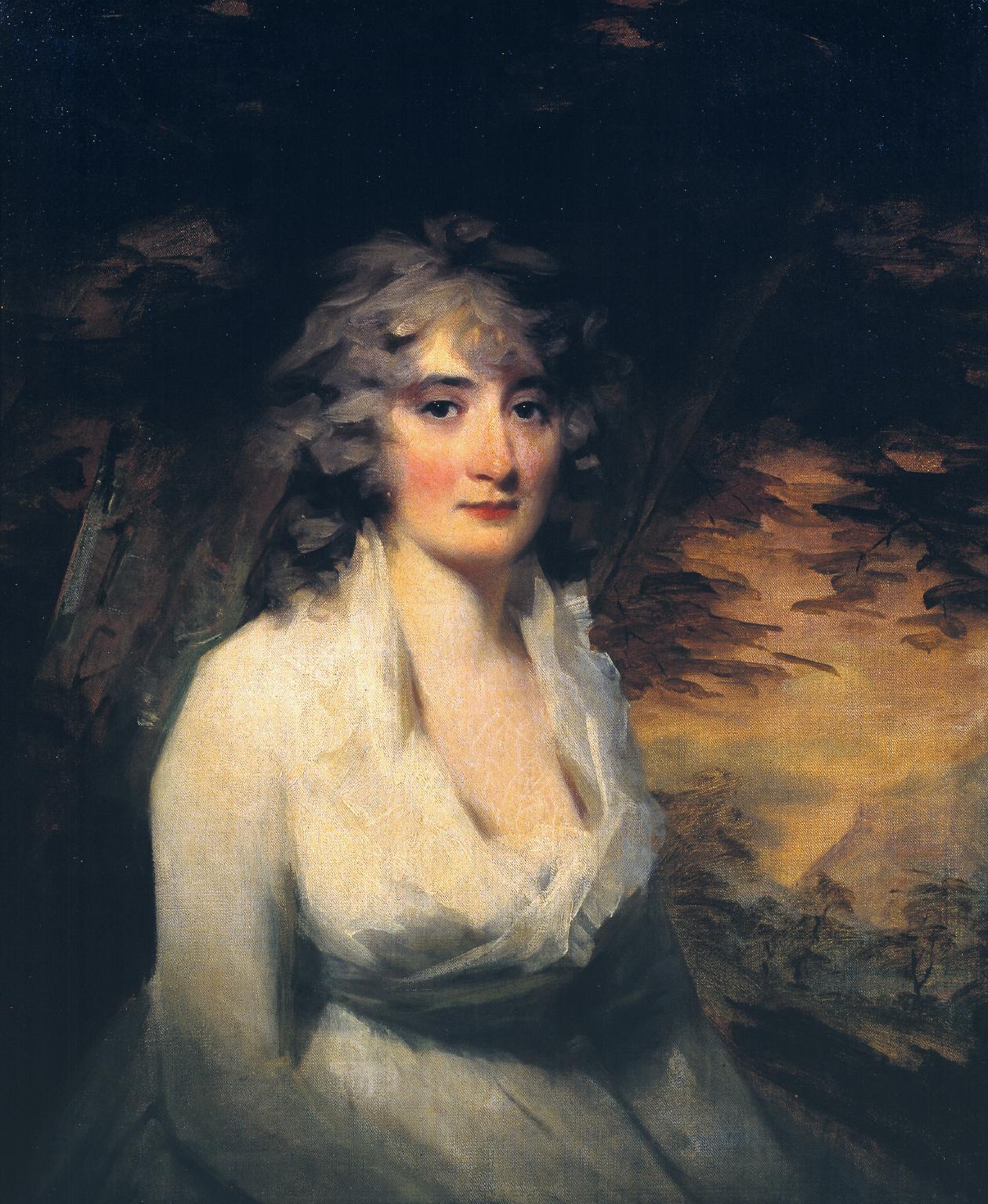
Sir Henry Raeburn, Mrs H.W. Lauzun ?1796
This medium-sized oil painting by the Scottish artist Sir Henry Raeburn depicts Anne Neale Lauzun (1776–1861), née Tucker. She is shown seated and wearing a white dress in front of a loosely painted landscape of trees, hills and a warm orange sky. A large tree dominates the composition on the left, framing the sitter, who is positioned just left of centre. She gazes forwards, her face framed by dark curls and her cheeks rosy. Light pools around her face and upper torso, while her hair recedes into the dark background. Compared with the delicate handling of the sitter’s face, the brushwork becomes broader in the rendering of the sitter’s hair, dress, and the landscape behind.
16/30
artworks in The Exhibition Age
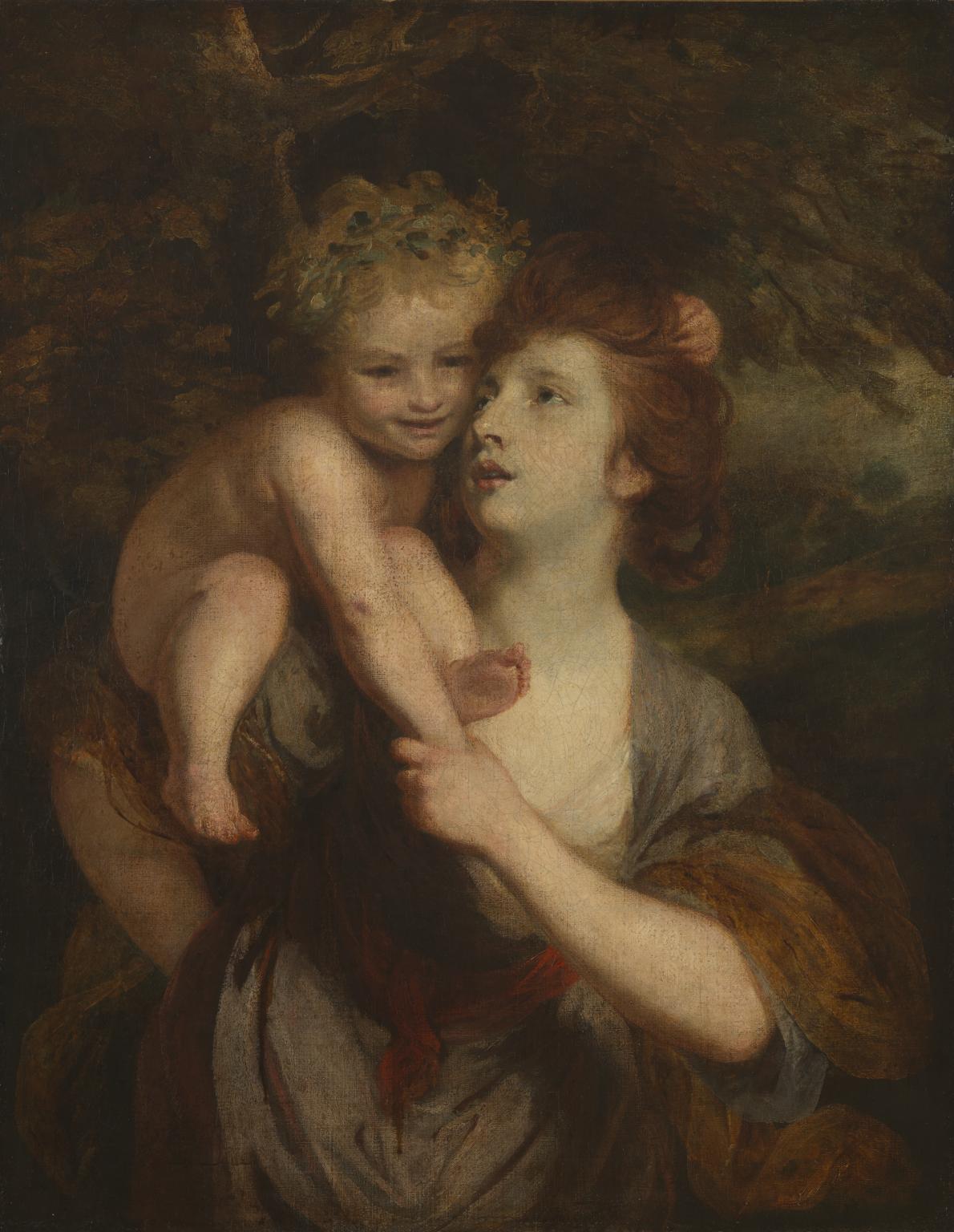
Sir Joshua Reynolds, Mrs Hartley as a Nymph with a Young Bacchus exhibited 1773
17/30
artworks in The Exhibition Age
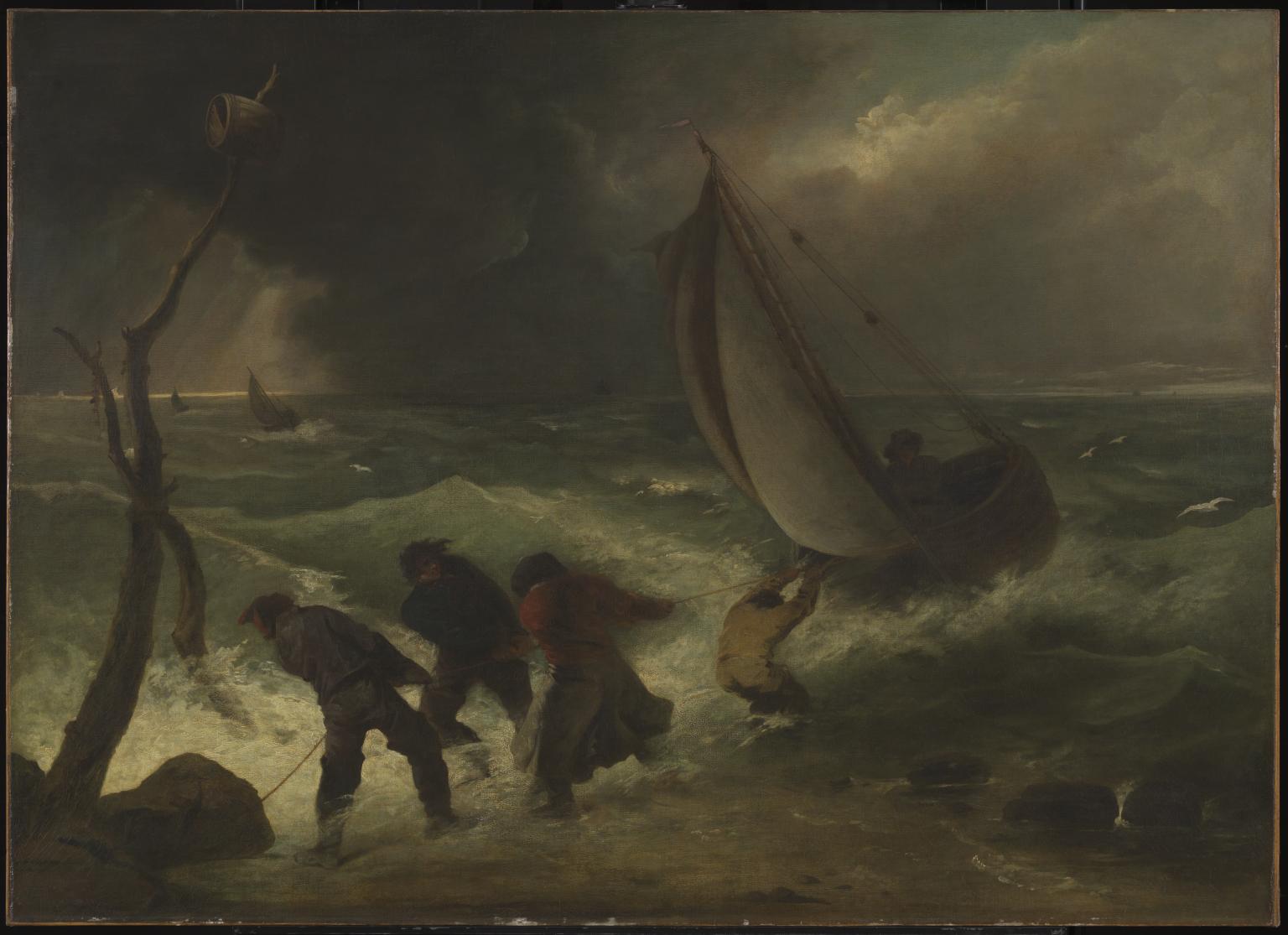
John Hoppner, A Gale of Wind c.1794
Hoppner originally intended to become a landscape painter. However, this seascape, shown at Royal Academy in 1795, is the only work other than portraits he is known to have exhibited.
Attention is focused on the large figures in the foreground as they battle against the raging wind and the overwhelming forces of nature. The scene is set just off St Catherine’s Point on the Isle of Wight, known for its treacherous waters.
Gallery label, September 2004
18/30
artworks in The Exhibition Age
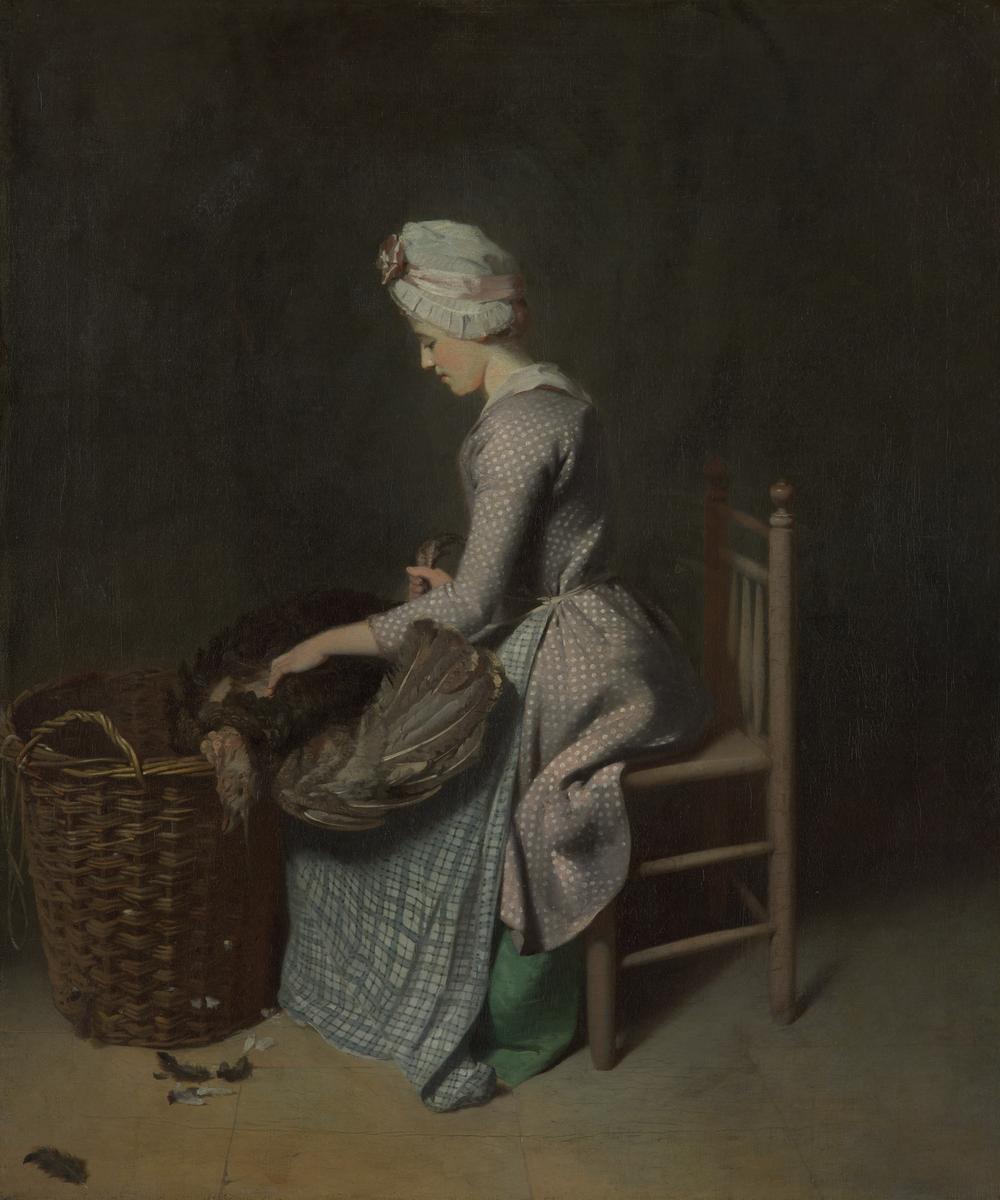
Henry Walton, Plucking the Turkey exhibited 1776
This painting was exhibited in London in 1776, during the early stages of the war with revolutionary America. Walton’s image of a cookmaid plucking a turkey is an example of the kind of lowly subject-matter denigrated by Sir Joshua Reynolds and the new Royal Academy.
But it may also make a coded political reference. The turkey was very closely associated with America: Benjamin Franklin even proposed that it should become the symbol of independent America, instead of the eagle. The painting may, therefore, be a pro-British comment on the anticipated fate of the rebellious colonists.
Gallery label, September 2004
19/30
artworks in The Exhibition Age
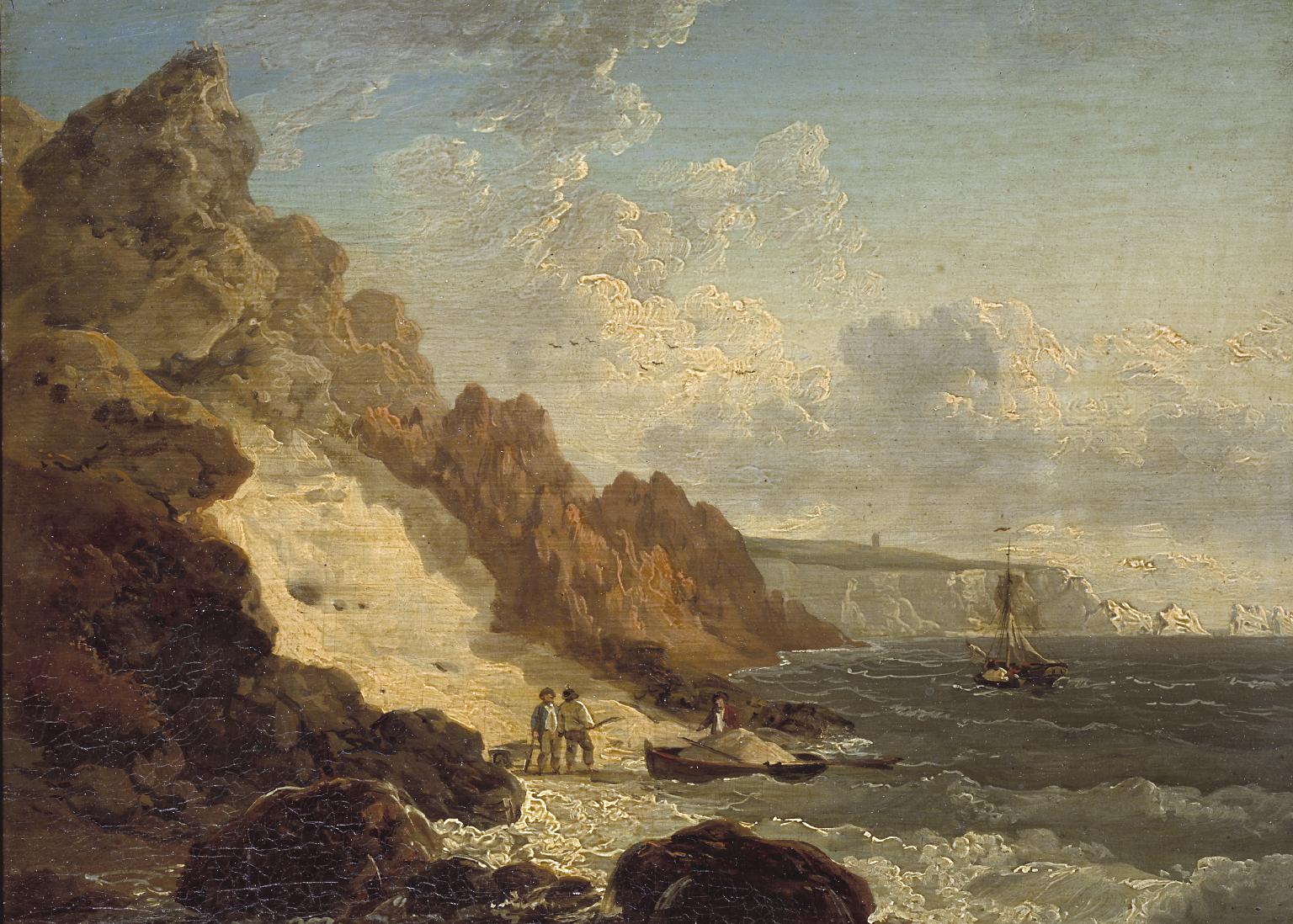
Julius Caesar Ibbetson, Sand Quarry at Alum Bay ?exhibited 1792
20/30
artworks in The Exhibition Age

John Hoppner, Miss Harriet Cholmondeley exhibited 1804
21/30
artworks in The Exhibition Age
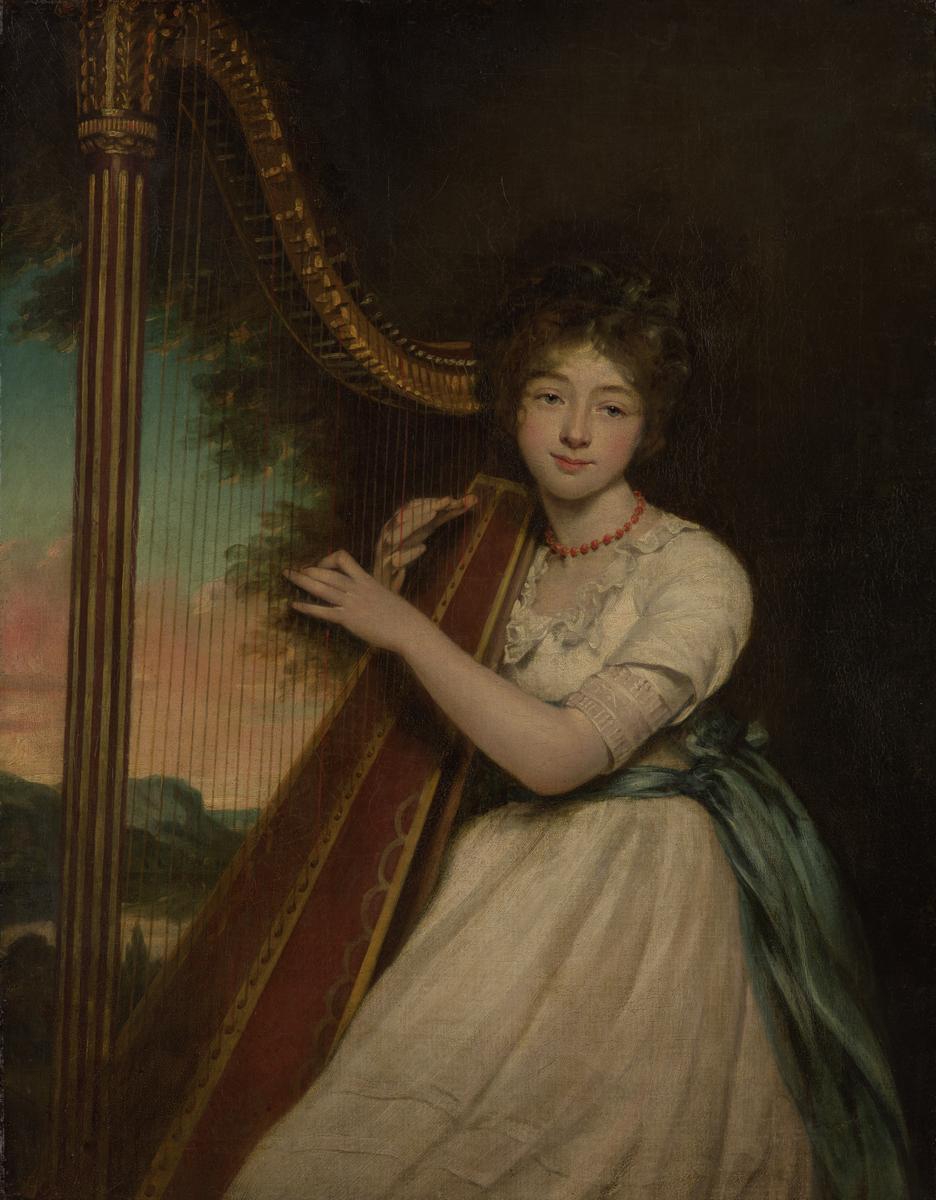
James Northcote, A Young Lady Playing the Harp ?exhibited 1814
A Young Lady Playing the Harp ?exhibited 1814 is an oil painting by the English artist and author James Northcote. It depicts a young harpist wearing a white dress tied with a long green sash, with a string of red beads around her neck. The harpist gazes forward, both hands raised to pluck the strings. She is seated against a rural backdrop dominated by a large, dark tree on the right, which frames her compositionally. The backdrop on the left, seen through the strings of the harp, features a twilit sky over hills and a lake.
22/30
artworks in The Exhibition Age
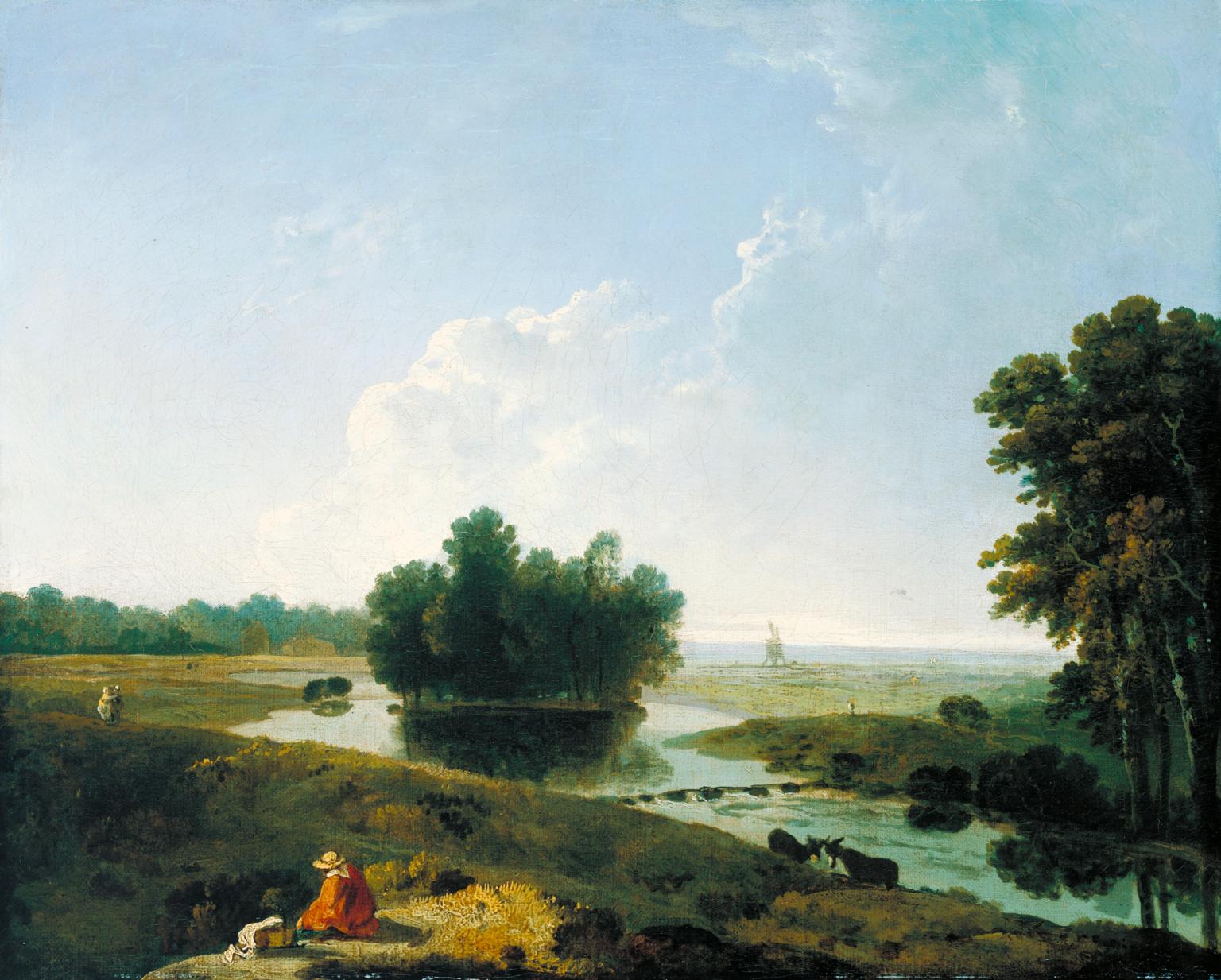
Richard Wilson, On Hounslow Heath ?exhibited 1770
The view shows the watermeadows beside the River Crane. This area of Hounslow Heath was not known for its beauty or cultural significance. Instead, the attraction of this picture lies in the beauty of the sky and the reflections in the water. In this it is an example of a new type of landscape view, designed to bring a vision of a rural idyll into the city dweller's home. The picture was commissioned by Tom Davies, who was a Bloomsbury bookseller, and one of a growing number of middle-class urban patrons of English landscape subjects.
Gallery label, September 2004
23/30
artworks in The Exhibition Age

Francis Cotes, Portrait of a Lady 1768
This elegant and ornamental portrait
is a fine example of Cotes's style, which emphasises fashion rather than character. The sitter, whose identity is uncertain, sits on a garden bench in an artificial yet striking pose. Her gown and its lace are arranged decoratively about her, the pink and white colouring echoed by the foxgloves behind her, and the roses on the left. The portrait was painted in 1768, the same year as the foundation of the Royal Academy. Cotes was one of its founder members, which his prominent signature on the tree trunk, 'F Cotes RA px', proudly announces.
Gallery label, February 2010
24/30
artworks in The Exhibition Age
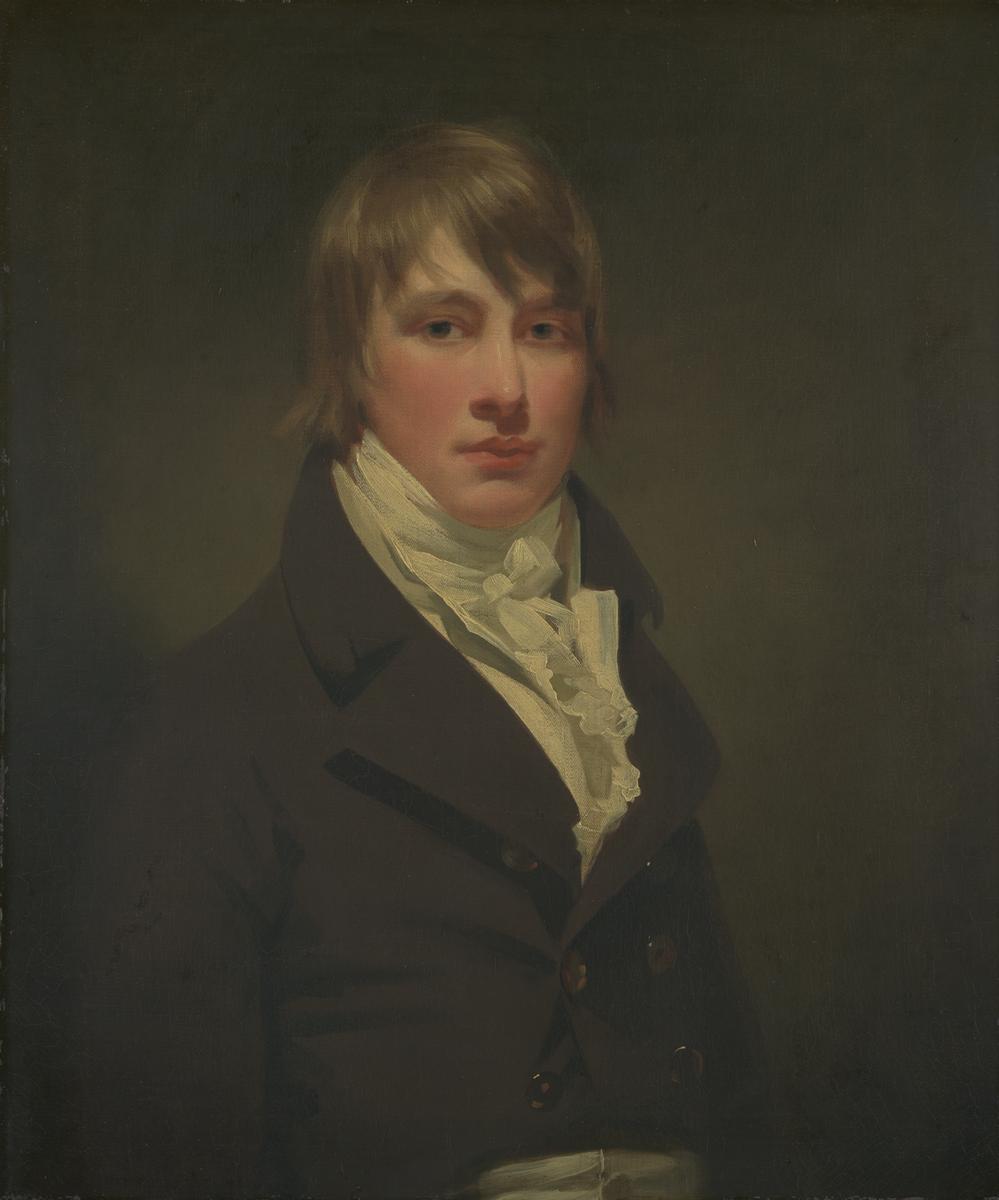
Sir Henry Raeburn, Pringle Fraser c.1804
25/30
artworks in The Exhibition Age
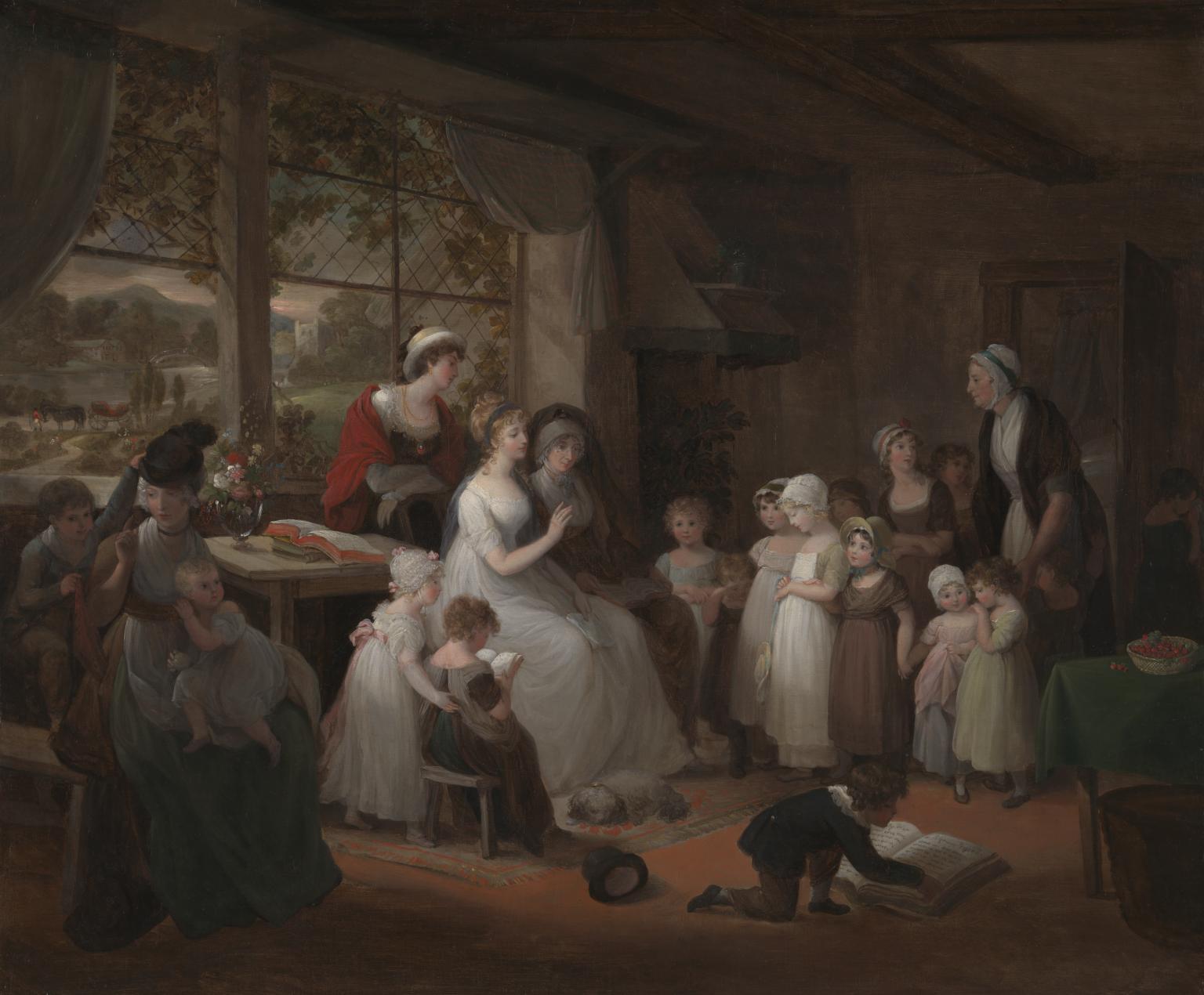
Maria Spilsbury, The Schoolmistress c.1803
26/30
artworks in The Exhibition Age
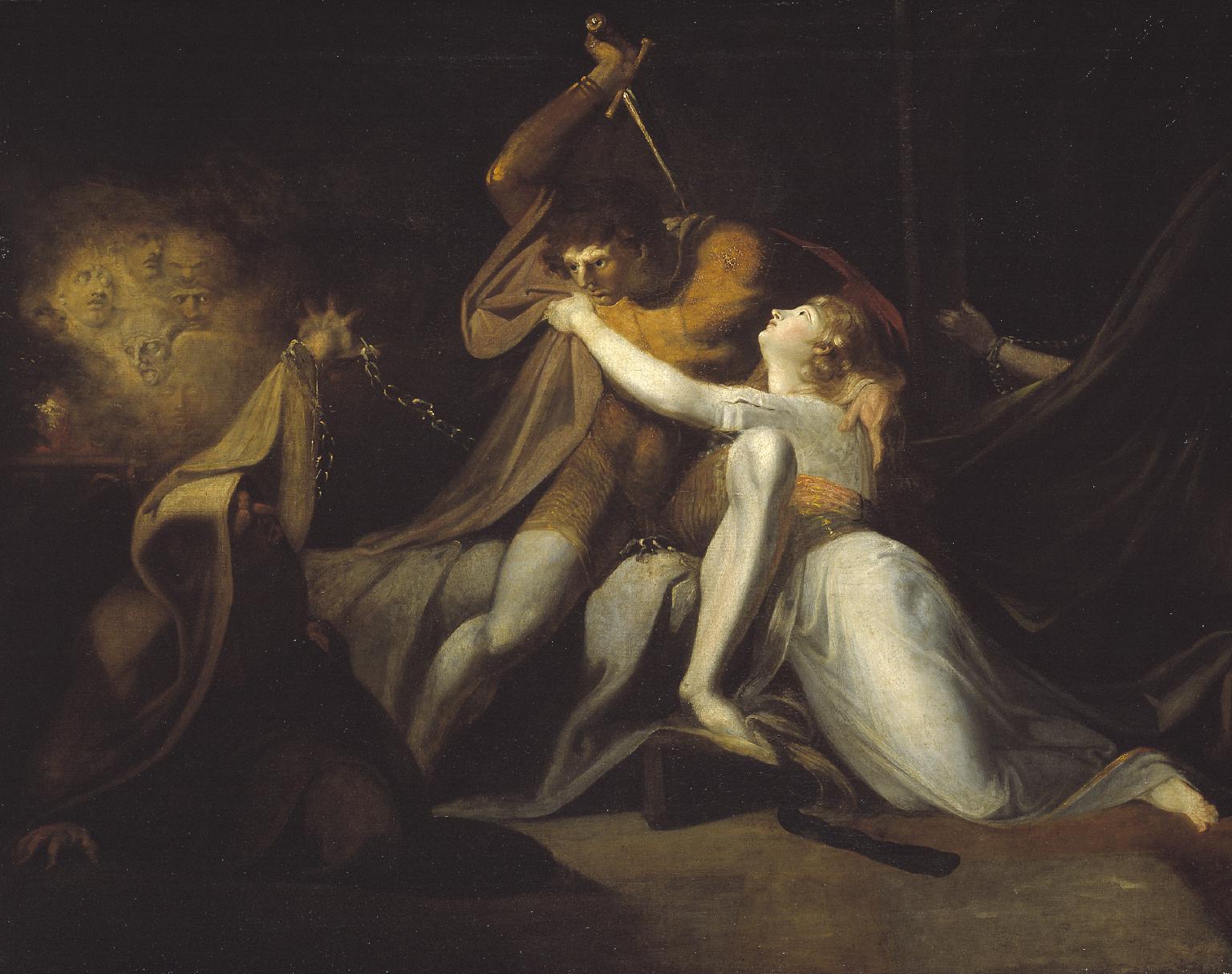
Henry Fuseli, Percival Delivering Belisane from the Enchantment of Urma exhibited 1783
Conventionally, history paintings were based on a literary or historical source familiar to educated viewers. The artist’s role was to select from the story a crucially significant moment that would convey a sense of nobility and moral certainty.
The success of this strategy of course depended on the viewer knowing the story, and so knowing what would happen next. Fuseli, however, admitted that he invented the saga of Percival and Belisane shown here. His paintings tended to emphasis spectacle and sensation rather then the noble themes and moral lessons which Reynolds’s view of the ‘great style’ demanded.
Gallery label, September 2004
27/30
artworks in The Exhibition Age
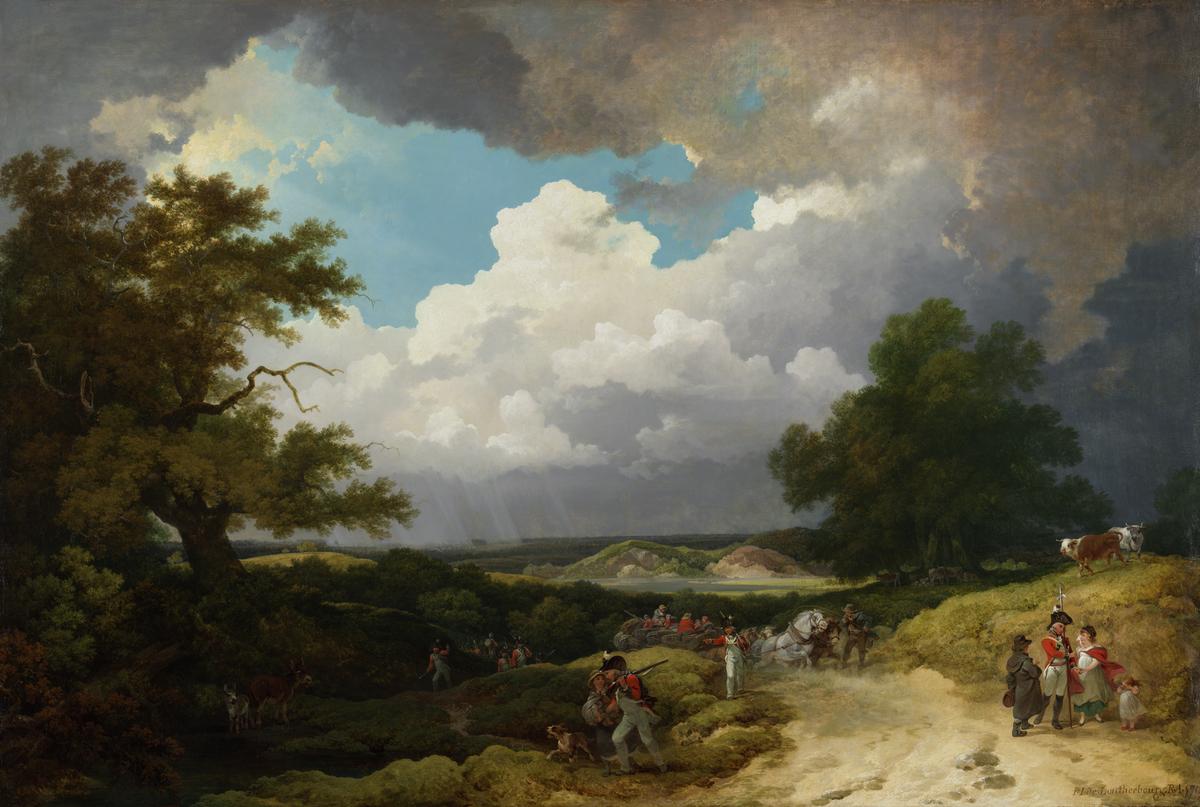
Philip James De Loutherbourg, A Distant Hail-Storm Coming On, and the March of Soldiers with their Baggage 1799
Loutherbourg’s picture is filled with foreboding. It was painted shortly after the French revolution and at the beginning of the wars with revolutionary France and its allies. The landscape is stormy and overcast, and peopled by soldiers. This reflects how the nation was becoming militarised and placed on a war footing, with military exercises and recruitment and conscription reaching even remote areas.
Gallery label, May 2007
28/30
artworks in The Exhibition Age
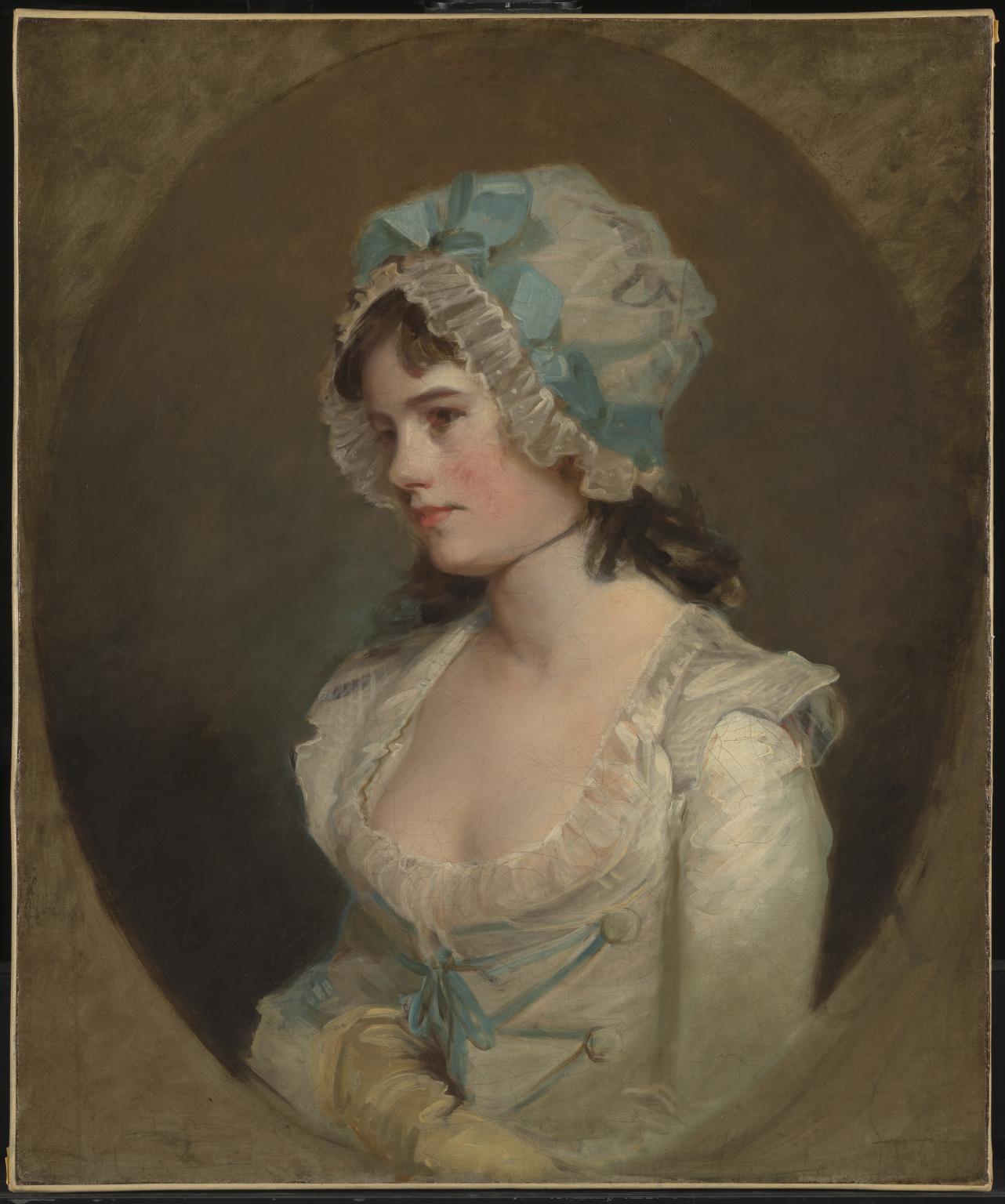
John Hoppner, Mrs Williams c.1790
29/30
artworks in The Exhibition Age
Sorry, no image available
Thomas Gainsborough, Sir Henry Bate-Dudley, Bart. c.1780
The Reverend Henry Bate (1745–1824) who assumed the name Bate-Dudley in 1784, was a tough-minded journalist and newspaper editor, as well as an Anglican parson. He had famously got into a fight with some young men of fashion in Vauxhall Gardens, earning him the nickname ‘The Fighting Parson’. For this portrait, his friend Gainsborough has included an adoring dog and an outdoor setting to emphasise the idea that he was a nature-loving ‘man of feeling’. The painting was exhibited at the Royal Academy in 1780. As a journalist, Bate-Dudley did much to promote Gainsborough’s reputation through positive exhibition reviews.
Gallery label, February 2016
30/30
artworks in The Exhibition Age
Art in this room





























Sorry, no image available
You've viewed 6/30 artworks
You've viewed 30/30 artworks
